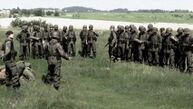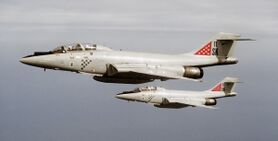Great Republican War: Difference between revisions
No edit summary |
No edit summary |
||
| Line 40: | Line 40: | ||
| combatants_header = | | combatants_header = | ||
| combatant1 = {{flag|Velikoslavia}}<br>{{flag|Veldia}}<br>{{flag|Mesogeia}}<br>{{flag|Usezoya}} | | combatant1 = {{flag|Velikoslavia}}<br>{{flag|Veldia}}<br>{{flag|Mesogeia}}<br>{{flag|Usezoya}} | ||
| combatant2 = {{flagicon|Ostrozava|Compact2}}{{flag|Ostrozava|Civil}}<br>{{flag|Ludvosiya}}<br>{{flag|Drevstran}}<br>{{flag|Schaumberg}}<br>[[File:Ostrozava-RheigenResistanceFlag.png| | | combatant2 = {{flagicon|Ostrozava|Compact2}}{{flag|Ostrozava|Civil}}<br>{{flag|Ludvosiya}}<br>{{flag|Drevstran}}<br>{{flag|Schaumberg}}<br>[[File:Ostrozava-RheigenResistanceFlag.png|24px]] DWFR<br>'''Supported by:'''<br>{{flag|Otomarca}}<br>{{flag|Talahara}}<br>{{flag|Tyreseia}} | ||
| commander1 = {{flagicon|Veldia}} Niels III<br>{{flagicon|Velikoslavia}} '''[[Nicholas I of Velikoslavia|Nicholas I]]''' <br> {{flagicon|Velikoslavia}} [[Jerod, Grand Duke of Angarsk|Jerod Wrenskold]] <br> {{flagicon|Velikoslavia}} X <br> {{flagicon|Velikoslavia}} X <br> {{flagicon|Velikoslavia}} X <br> {{flagicon|Velikoslavia}} X <br> {{flagicon|Velikoslavia}} X <br> {{flagicon|Velikoslavia}} X <br> {{flagicon|Velikoslavia}} X <br> {{flagicon|Velikoslavia}} X <br> {{flagicon|Velikoslavia}} X | | commander1 = {{flagicon|Veldia}} Niels III<br>{{flagicon|Velikoslavia}} '''[[Nicholas I of Velikoslavia|Nicholas I]]''' <br> {{flagicon|Velikoslavia}} [[Jerod, Grand Duke of Angarsk|Jerod Wrenskold]] <br> {{flagicon|Velikoslavia}} X <br> {{flagicon|Velikoslavia}} X <br> {{flagicon|Velikoslavia}} X <br> {{flagicon|Velikoslavia}} X <br> {{flagicon|Velikoslavia}} X <br> {{flagicon|Velikoslavia}} X <br> {{flagicon|Velikoslavia}} X <br> {{flagicon|Velikoslavia}} X <br> {{flagicon|Velikoslavia}} X | ||
| commander2 = {{flagicon|Ostrozava|Compact2}} [[List_of_heads_of_state_of_Ostrozava|Alek Dalibor]]<br>{{flagicon|Ostrozava|Civil}} [[List_of_heads_of_state_of_Ostrozava|Elias Manninger]]<br>{{flagicon|Ostrozava|Civil}} [[List_of_heads_of_state_of_Ostrozava|Oskar Beránek]]<br>{{flagicon|Ostrozava|Compact2}}{{flagicon|Ostrozava|Civil}} Harlo Moravec | | commander2 = {{flagicon|Ostrozava|Compact2}} [[List_of_heads_of_state_of_Ostrozava|Alek Dalibor]]<br>{{flagicon|Ostrozava|Civil}} [[List_of_heads_of_state_of_Ostrozava|Elias Manninger]]<br>{{flagicon|Ostrozava|Civil}} [[List_of_heads_of_state_of_Ostrozava|Oskar Beránek]]<br>{{flagicon|Ostrozava|Compact2}}{{flagicon|Ostrozava|Civil}} Harlo Moravec | ||
Revision as of 14:13, 1 October 2024
This article is incomplete because it is pending further input from participants, or it is a work-in-progress by one author. Please comment on this article's talk page to share your input, comments and questions. Note: To contribute to this article, you may need to seek help from the author(s) of this page. |
| Great Republican War | |||||||
|---|---|---|---|---|---|---|---|
| Part of Belisarian Cold War Other | |||||||
From top to bottom, left to right: Veldian troops convene before the Second Battle of Helbarstatt, 1956 • Velikoslavian T50100 tanks occupy Garagorsk, 1957 • Ludvosiyan troops during the Battle of CITY, 1960 • Velikoslavian advance into LOCATION, YEAR • Mesogeian troops prepare for an assault, 196X • Ostrozavan LLv.48-57/D fighter-bombers on patrol in the Levigorsk Corridor, 1959 | |||||||
| |||||||
| Belligerents | |||||||
|
|
Supported by: | ||||||
| Commanders and leaders | |||||||
|
|
| ||||||
| Strength | |||||||
|
|
| ||||||
| Casualties and losses | |||||||
| 1,600,000 | 1,500,000 | ||||||
| 3,000,000+ civilians | |||||||
The Great Republican War, also known as the Transkupalnitsan War or the Reclamation War, refers to a series of closely connected conflicts fought in eastern and central Belisaria between 1952 and 1963. The conflict began as a war between Ostrozava and Veldia lasting between 1952 and 1957, and later evolved into a regional conflict pitting Ostrozava, Ludvosiya, and Drevstran against Veldia, Mesogeia and Velikoslavia, lasting between 1958 and 1963. The initial phase of the conflict began when, influenced by the Budenitsa movement, the region of Rheigen, which had been under Veldian control since the end of the Containment War in 1928, revolted against Imperial rule, fuelled by concerns that Veldia was preparing to commit cultural genocide on the local population through cultural assimilation and imposition of state religion.
Names
Background
The origins of the Great Republican War lie in the fallout from the Containment War and Belisarian Cold War, and ultimately from the geopolitical and social consequences of the Crimson Revolution and Thirty Years' War. The Prime Republic of Ostrozava, at the time a relatively unstable and nascent polity, had been dealt serious blows during the Containment War by mutual successful incursions from Veldia and Velikoslavia. Most notably, at the Treaty of X, Veldia had been granted control of the Ostrozavan region of Rheigen, a Magnish-speaking region of southwestern Transkarminia, against Ostrozavan protests. As a result of the treaty, Ostrozava had also been forced to scuttle the last remnants of the Transkarminian Kupalnitsa Flotilla, and give up custody of former Transkarminian nobles. Already during the war Ostrozava had increasingly turned towards orthosocialist interpretations of its founding documents with the election of Emil Torje. After the war, Alek Dalibor took power after Emil Torje's presumed assassination in a car accident. While implementing infamously socially restrictive policies at home, Dalibor ignored the terms of the treaty and greatly invested in remilitarization and heavy industry, including through contributing troops to the Great Ottonian War. In 1949, Ostrozavan intelligence, the PRCO, began a chemical weapons program known as the Red Stream Experiment, which failed at generating weapons but introduced Metalysergine, a powerful hallucinatory drug, to the populations of Ostrozava, Rheigen, and Veldia, thus spurring a counterculture that led to opposition both to Dalibor's increasingly tightening control within Ostrozava and to often-violent Veldian attempts to assimilate the Rheigners into Thromrish ethnic norms.
Velikoslavia and Ludvosiya had by this point been engaged in the early stages of the Belisarian Cold War, which began in the early 1950s as tensions and hostility grew between the two nations. Velikoslavia had introduced several key armamment advancements, such as the Gu-18, which created a platform capable of striking anywhere within Ludvosiya. Ludvosiya, for its part, maintained a large army and participated in regular saber rattling. It seemed all but inevitable that the two nations would eventually fight another war, as they had been since Ludvosiyan independence from Velikoslavia. Key differences in matters such as religion coupled with Danil IV's increasingly aggressive foreign policy stance would leave his son, Nicholas I, with a well-equipped and dangerous fighting force that possessed a nationalistic fervor to see the old Velikoslav empire rebuilt. Ludvosiya, for its part, was under the thumb of a nationalistic government who abhorred monarchies and organized religion, key tenets of its northern neighbor, and fully believed it would destroy its perceived oppressor. Its own military staff was sold out to such thinking, opposing Velikoslavia at every turn just short of open war. Neither force was particularly inferior to the other and both were well-equipped and capable of waging a significant conflict.
In far eastern Belisaria, [insert smaller paragraph here].
Phase I
> 1956 - Political agitation in Ostrozava distracts from maintaining an offensive balance. Fighting turns to stalemate as many troops turn on their officers / support the anti-Dalibor movement
> early 1957 - Ostrozavan Army flips against Second Compact
> 1957 - Third Compact is formed in Ostrozava; Ostrozava now under military control (Prime Defense Council)
Phase II
Velikoslavian Invasion
Operation Ragnarok 1957-1959
On June 6, 1957, the recently crowned Nicholas I looked south to reassert Velikoslavian control over Baderia, which it had historically held for several centuries. His father had invested singificant resources into the military, leaving him with a significant force. Intending to eventually challenge Ludvosiya, it was theorized that weakening Ostrozava would contribute to this goal and weaken potential Ludvosiyan allies. Decades of tensions with successive Ostrozavan regimes since the Crimson Revolution came to a boiling point, resulting in a formal declaration of war by Velikoslavia on June 8, 1957, with the intention of striking Ostrozava down while it was weak from the fall of Alek Dalibor and regaining historic territory.
At the same time the declaration was presented, the I Corps and the II Corps, comprised of 500,000 men, crossed into Baderia spearheaded by mechanized and armored portions of the military under Lord-Marshal Jerod Wrenskold. The advance was characterized by rapid air strikes and heavy artillery usage, which quickly overwhelmed the city of Garagorsk on June 10. By June 12, Vyshnaya had fallen to the 5th army. Ostrozavan forces under the command of X had recovered enough from their initial disorganization by June 13, and formed a defensive line consisting of [FORMATIONS] and manned by [TROOP NUMBER] which stretched along the [RIVER] from Barderec to Serpin. It was at the [NAME FOR DEFENSIVE LINE] that some of the heaviest fighting of the first year occurred and resulted in the Velikoslav offensive stalling for two months. During the interim, Nicholas I ordered the commencement of Plan Omega, which consisted of a concentrated air campaign to cripple Ostrozavan industry, which began with several air strikes against key targets in Barderec on June 15.
Seige of Barderec
Ostrozavan Counterattack 1959 -1961
Successive Campaigns
Treaty of Barderec
-1963 - DMZ formed that still exists today
Southern Theater
Mesogeia comes over to see Ludvo and gives them a bonk
Northern Theater
Ludvo-Veliko border overe here being lit up by artillery for 5 years
Eastern Theater
Mesogeia sends a battalion of geriatrics into battle(?)
Impact
Casualties and war crimes
Occupation
International law
See also: International law





